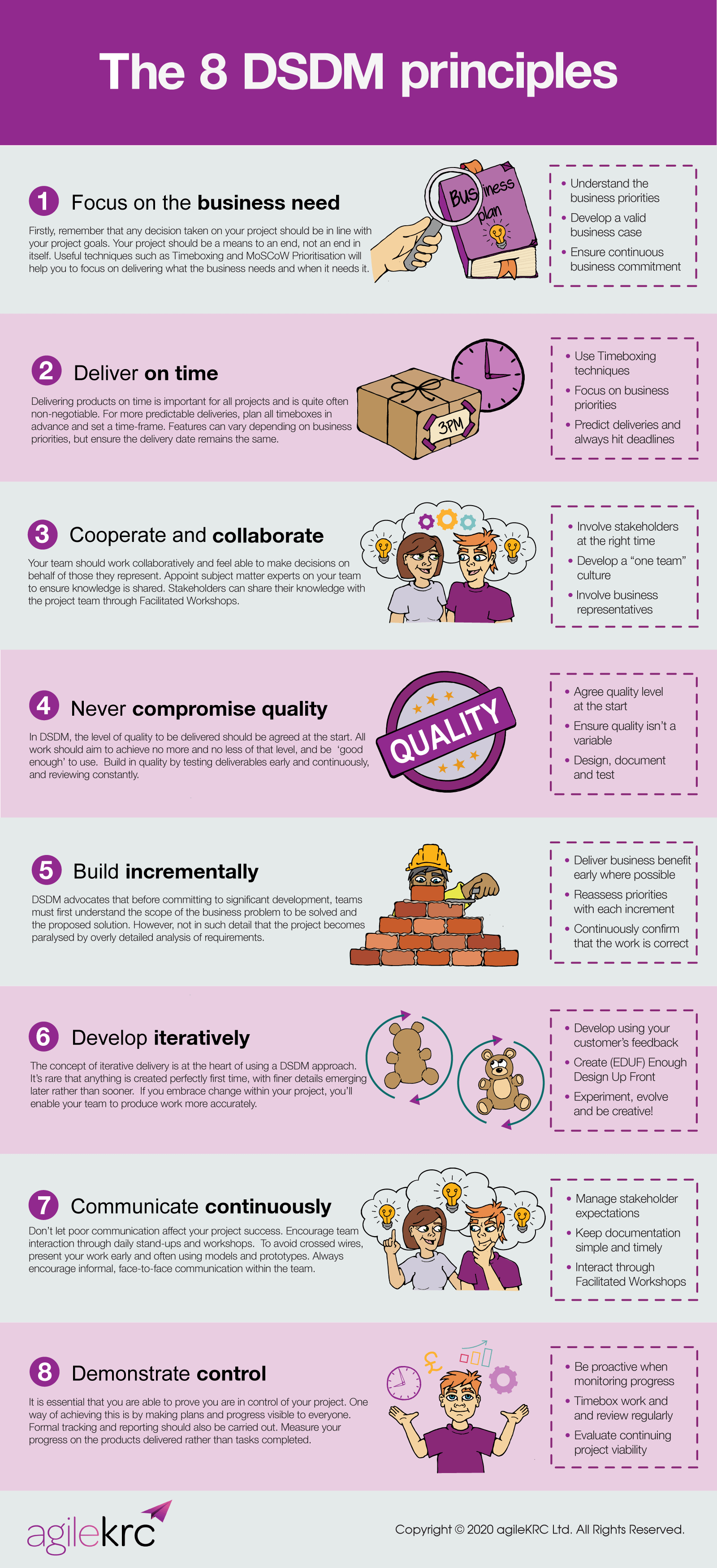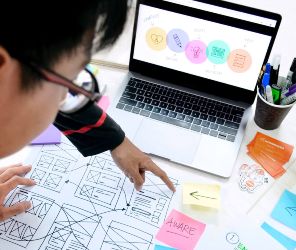
Inception
Dynamic Systems Development Method (DSDM) is often viewed as a hidden treasure within the Agile landscape. Established in 1995, DSDM has the longest pedigree among Agile methods and is unique in its focus on Agile project management.
Post-2000, DSDM started to gain traction among software developers looking for alternatives to rapid application development (RAD) methodologies. One notable issue with RAD was its limited scalability for team collaboration. DSDM tackled this problem by encouraging collaboration within teams and at scale, making it one of the earliest Agile methodologies adopted within the software development community.
DSDM was involved in the creation of the Agile Alliance and the Agile Manifesto in 2001. Its principles and philosophy helped shape the Manifesto for Agile Software Development, even though DSDM extends the Agile concept beyond just software.
To put it simply, DSDM was Agile before Agile was a recognized concept!
DSDM Atern Inception
In 2007, a considerable update to the DSDM approach led to the development of DSDM Atern. The term ‘Atern’ was taken from the Arctic Tern, a bird distinguished for its highly cooperative behavior and capability to travel long distances.
This metaphor served as an ideal representation for the rebranding of the DSDM method.
By 2014, confusion related to the term ‘Atern’ necessitated another update to the method. It was decided to revert to the original DSDM name, which was widely recognized. Thus, DSDM and DSDM Atern now share the same meaning!
The DSDM Agile Project Framework Evolution
The 2014 rebranding of DSDM included the introduction of the Agile Project Framework. The DSDM Agile Project Framework is now the preeminent, proven agile approach that addresses the dual needs of today’s organizations: governance and rigor, along with agility and flexibility.
DSDM’s Agile Project Framework supports organizations in addressing typical project issues, such as delayed deliveries, cost overruns, or final deliverables not being fit for their intended purpose.
AgilePM: A DSDM Innovation
DSDM emerged as the first agile framework to integrate agile project management capabilities. While Scrum concentrates solely on product delivery during an iteration, DSDM also covers project management aspects, distinguishing it from most other agile frameworks.
DSDM’s aptitude for addressing a variety of agile needs led to its selection as the basis for the fast-growing AgilePM (Agile Project Management) qualifications, accredited by APMG International and the Agile Business Consortium.
DSDM – An Agile Solution Framework
DSDM is an iterative agile framework originally designed to deliver software projects more efficiently. Like other agile frameworks and approaches, DSDM was developed in response to the problematic waterfall processes that had become widespread in the software development industry during the late 20th century.
DSDM’s Progress
DSDM is now progressing as agile methodologies mature. This progress is due to organizations requiring greater rigor and control when implementing agile in situations where the ‘ideal agile environment’ is not present.
DSDM is an agile method that caters to both simple product development projects with co-located teams and more complex projects involving multiple distributed teams across different countries and time zones. DSDM can scale up to accommodate multiple teams working in distributed settings, a feature that scaled agile frameworks have only recently begun to offer.
DSDM Essentials
Not Solely IT-oriented
While DSDM’s history, like most agile frameworks and methods, is based in the software development industry, agile has advanced over the past decade and is no longer exclusive to IT.
DSDM can be readily applied to projects beyond software development. In fact, it can be employed in any type of product development project. By delivering a functional product incrementally at the conclusion of each timebox, DSDM can offer business value early in the product development lifecycle.
DSDM: Individual or Merged
The DSDM Agile Project Framework can be utilized either as an individual approach or merged with other established project management methods like PRINCE2, MSP, and PMI.
It is also ideal as a wrapper for more limited Agile approaches such as Scrum, ensuring the whole project lifecycle is addressed. DSDM also allows Scrum to be scaled up for purposes beyond just product development.
DSDM Framework

DSDM is an agile project framework that encompasses several key elements:
- philosophy
- people
- practices
- principles
- process
- products
- pragmatism and common sense.
These elements collectively support a philosophy of delivering business benefits as early as possible, ensuring the optimal return on investment (ROI) for an organization.
DSDM’s ‘rationality and pragmatism’ might appear unusual to some, but this flexibility allows DSDM to bypass the dogma that can sometimes affect other Agile approaches.
A foundational assumption of DSDM is that nothing is built perfectly on the initial attempt. Generally, 80% of a solution’s value can be delivered for 20% of the effort required to produce the entire solution.
By emphasizing the business need, DSDM supports projects that strategically align with an organization’s change portfolio.
DSDM Principles
DSDM consists of 8 principles that embody its ethos, culture, and way of working. These principles must be actively managed throughout a project, as compromising a principle may pose a risk to the successful execution and completion of the project.
DSDM adheres closely to agile principles, emphasizing delivery, effective communication, collaboration, and continuous delivery. All DSDM principles help align DSDM practices with the agile philosophy.
Understanding the guiding principles of DSDM is essential if you plan to take an agile project management course like AgilePM®, which is based on the DSDM method.
We will now look at the 8 DSDM principles.
1. Focus on the business need
- Understand business priorities.
- Create a valid business case.
- Enable continuous business commitment.
Every decision taken during your project must be in line with overarching project aims. Projects should act as a tool to achieve long-term business objectives. Techniques such as MoSCoW and timeboxing aid in keeping the focus on delivering what businesses need, when they need it.
2. Deliver on time
- Use timeboxing.
- Focus on priorities.
- Predict deliveries.
Sticking to delivery timelines is frequently non-negotiable. For predictable delivery outcomes, schedule timeboxes in advance. Features can differ, but the delivery dates should always be maintained.
3. Cooperate and collaborate
- Promote stakeholder collaboration.
- Focus on team building.
- Work with business representatives.
Teams should work cooperatively and make choices for the individuals they are representing. Have subject matter experts in your team to ensure the open exchange of information. Stakeholders can provide their expertise and personal experiences to project teams through frequent workshops.
4. Never compromise quality
- Set quality level at the start.
- Ensure quality doesn’t vary.
- Document and test.
The intended quality level should be established at the start. All work must aim to fulfill this predetermined standard. Assess deliverables as soon as possible and continuously monitor them.
5. Build incrementally
- Deliver business benefit early.
- Reassess priorities with each iteration.
- Confirm that the work is correct.
DSDM asserts that before initiating development, teams must have a solid grasp of the business problem’s scope. Steer clear of entangling oneself in overly complex requirements analysis that may hinder development.
6. Develop iteratively
- Use customer feedback.
- Create Enough Design Up Front (EDUP).
- Evolve and be creative.
The essence of DSDM revolves around iterative delivery. Be aware that it’s infrequent for anything to be perfect initially, and embracing alterations in your project is necessary for triumph.
7. Communicate continuously
- Manage expectations.
- Keep documentation simple.
- Interact through workshops.
Champion team communication through stand-ups and workshops. Share your progress early and frequently with models and prototypes. Encourage ongoing informal, face-to-face conversations among team members.
8. Demonstrate control
- Be proactive.
- Timebox work and review regularly.
- Evaluate project viability.
Advance project control by making plans and progress visible to all involved. Implement formal documentation standards. Assess your progress by focusing on the products delivered, not the tasks completed.
Processes
DSDM utilizes both iterative and incremental approaches. Early delivery is prioritized for the most critical business needs, while less vital ones are addressed later.
With its iterative nature, DSDM offers business representatives the opportunity to observe an evolving solution, submit feedback, and request modifications throughout the development process.
Phases
The DSDM process model features 6 phases. It is unique among many Agile methods due to the inclusion of a pre-project phase and post-project phase, which extend beyond just delivery.
DSDM phases include:
- Pre-project.
- Feasibility.
- Foundations.
- Evolutionary development.
- Deployment.
- Post-project.
People
DSDM brings together people from business and development stakeholder groups during the iterative and incremental progression.
All project members have clear roles and accountabilities and work collectively in timeboxes to maintain the project’s timeline.
The project manager’s responsibilities are uniquely defined in DSDM compared to other Agile approaches.
Practices
DSDM proposes 4 essential practices.
Timeboxing
Like many agile frameworks, DSDM plans work in fixed time intervals (timeboxes), similar to sprints in Scrum. The aim is to deliver a functional product at the end of each iteration (timebox). As a result, DSDM adopts both an incremental and iterative approach to product development.
Facilitated workshops
Facilitated workshops gather project stakeholders to collaborate on defining business requirements and building mutual understanding.
Modelling and iterative development
Through modeling, team members can visualize the business domain, enhancing their comprehension of it. Modeling assists in creating schematic depictions of particular aspects of the system or business area under development.
DSDM relies on a brief customer feedback loop to deliver a functional software increment at the end of each iteration. The MoSCoW prioritization method is recommended for sorting requirements to be tackled by the team during a timebox. These requirements are commonly captured as user stories.
Prototyping is another essential aspect of DSDM. The goal is to create a product rapidly, obtain prompt feedback, and identify potential issues early on. The foundational DSDM principle emphasizes the importance of discovering what may not work as soon as possible, allowing for adjustments to be made in a timely manner.
MoSCoW prioritization
The MoSCoW prioritization method aids businesses in classifying their requirements by identifying Must have, Should have, Could have, and Won’t have elements within each timebox.
DSDM and Scrum Differences
Many individuals in the Agile community mistakenly identify Scrum as a project management system. In reality, Scrum is a development methodology that encourages team collaboration on project and non-project tasks in order to iteratively develop valuable products for customers.
Scrum does not address activities that occur before a project (pre-project) or after a solution is deployed (post-project). The pre-project phase involves assessing the project’s value, while the post-project phase focuses on measuring the solution’s benefits and identifying any required improvements.
On the other hand, DSDM covers the pre-project and post-project stages and defines the project manager’s responsibilities. DSDM serves as an agile project management framework, whereas Scrum is a product delivery framework. However, Scrum can be applied within DSDM projects during the remaining four project stages.
DSDM infographic
The following infographic shows the DSDM principles in greater detail.

Summary
The DSDM Agile Project Framework is a trusted and battle-tested approach to agile project delivery, successfully utilized in countless projects worldwide.
DSDM currently holds the unique position of being the only agile project management framework. The framework has continually displayed its ability to work efficiently within and complement existing corporate processes.
Since 1994, DSDM’s application in both IT and non-IT projects has led to substantial productivity improvements, which have been independently verified by the UK Software Metrics Association.
For more details on how DSDM can enhance your Agile project delivery, or for information about agile project management training, please reach out to us at agileKRC.
agileKRC has helped shape agile thinking by leading the teams that developed AgilePM® and PRINCE2 Agile®. We take a practical, success-oriented approach. We begin by taking the time to listen and understand your needs, before offering our real-world experience and expert guidance.













